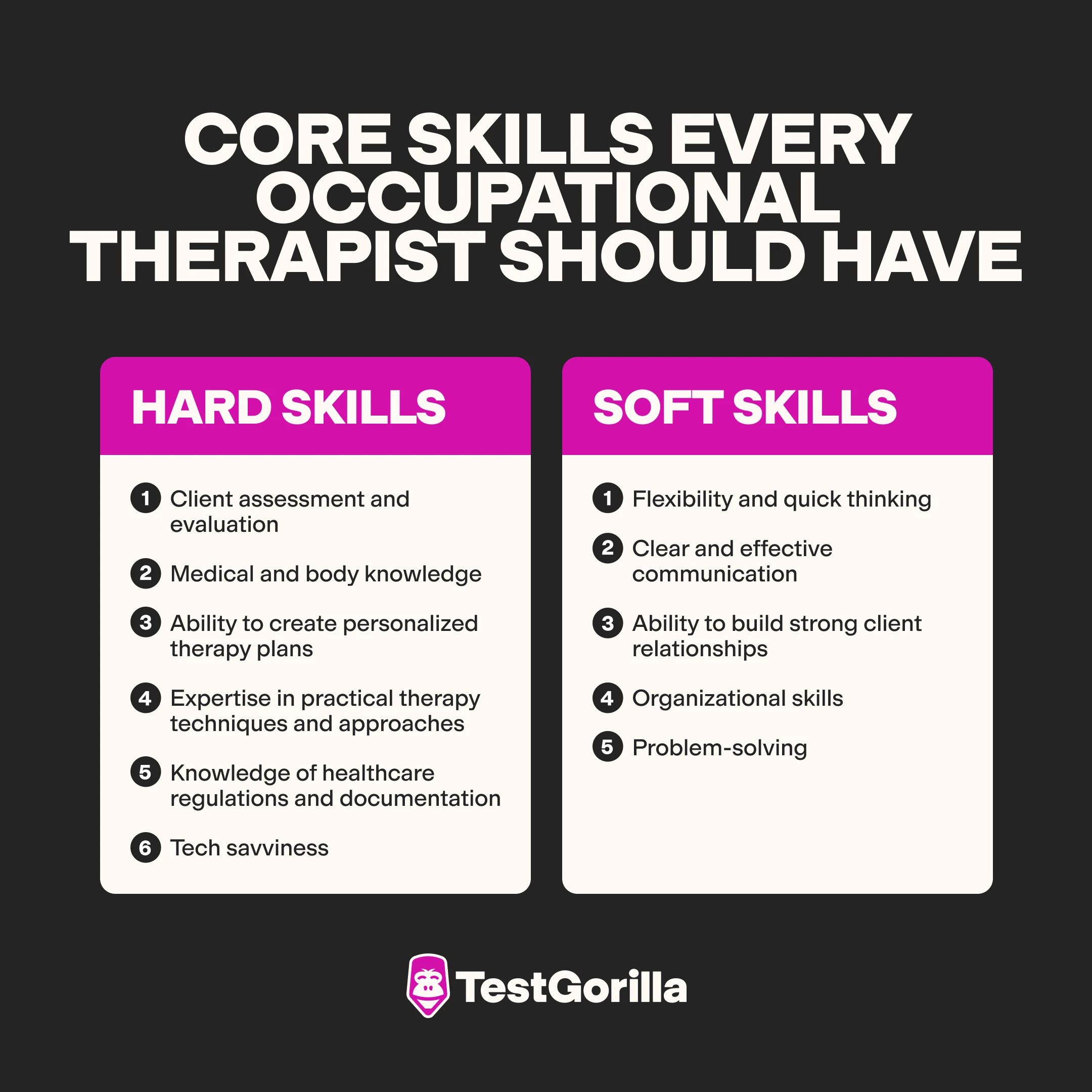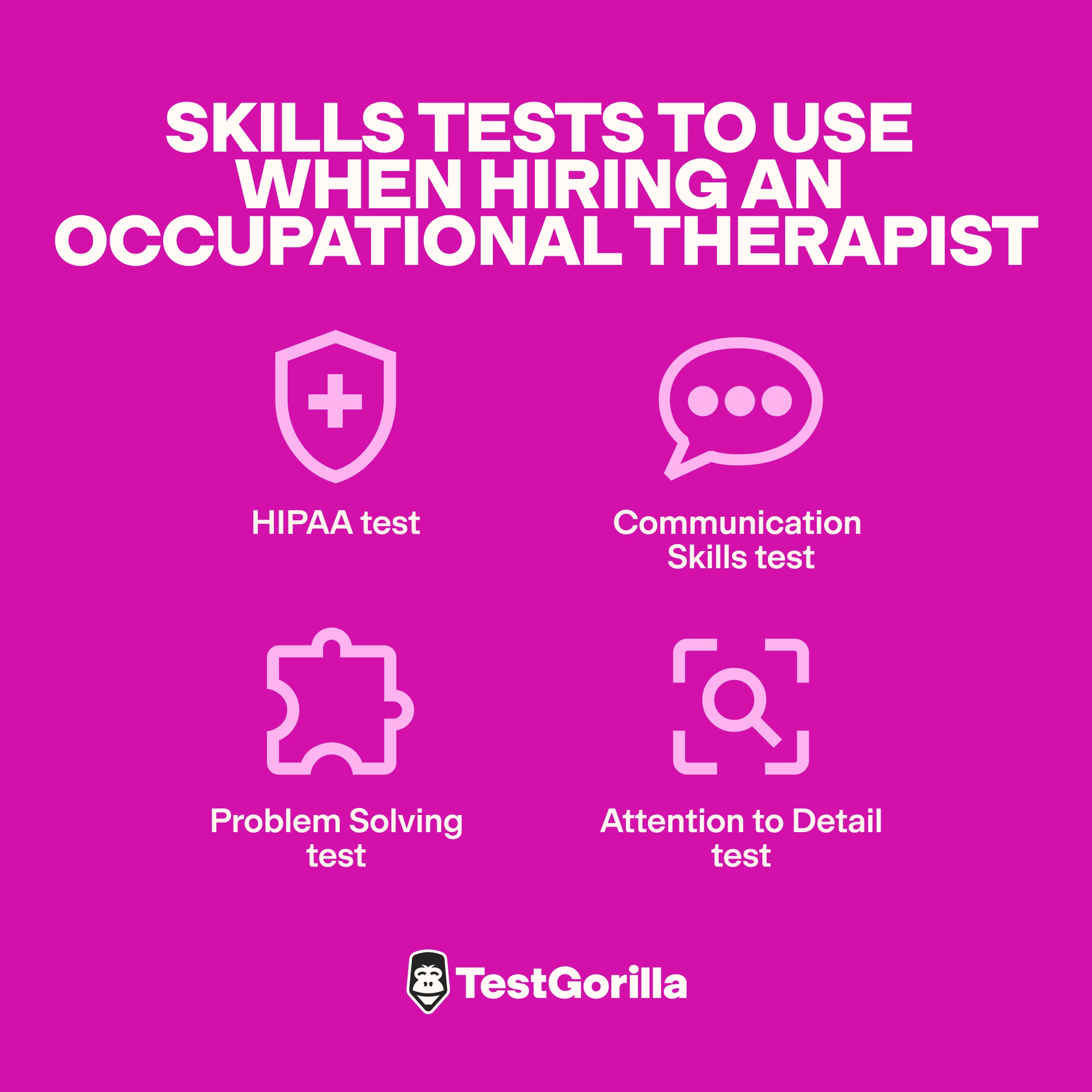Need an occupational therapist who can truly make a difference? You’re looking for someone who can develop personalized therapy plans to help clients gain independence in their daily activities.
Whether they’re working with kids, adults, or seniors, an OT should be able to boost their clients’ physical, cognitive, and emotional skills. Hiring the right person can elevate the quality of care and improve client outcomes. However, a bad hiring choice can result in ineffective therapy, communication issues, and more.
We’re here to help you find the perfect fit. Follow our guide to learn how to hire a talented and caring occupational therapist for your team.
Table of contents
- What is an occupational therapist?
- Tips for writing an occupational therapist job description
- Where to find occupational therapist candidates
- How to test your future occupational therapist’s skills
- Top interview questions for an occupational therapist
- Mistakes to avoid when hiring occupational therapists
- FAQs
- Hire top occupational therapists with TestGorilla
What is an occupational therapist?
An occupational therapist (OT) supports individuals of all ages who face physical, mental, or cognitive challenges. They use everyday activities as therapy to help these clients gain independence, and they also modify environments, recommend assistive devices, and teach new skills.
But what does that really mean?
On a typical day, an OT might work with kids who have developmental delays, adults recovering from injuries, or seniors dealing with age-related challenges. They assess each person's unique needs and create personalized plans to help them improve skills, regain independence, and enhance their quality of life.
This could involve various tasks – from teaching someone how to dress themselves again after a stroke, to helping a child improve their handwriting using pencil grips and graph paper, to making home modifications to create a safer living environment.
OTs are also team players – they often collaborate with other healthcare professionals, families, and caregivers to provide the best support for their clients.
Their therapy plans help bring meaningful improvements in their clients’ lives.
11 skills to look for in an occupational therapist
Here’s a quick rundown of the must-have skills for occupational therapists.
Hard skills
Look for these hard skills when vetting OT candidates:
Client assessment and evaluation: Effective therapy starts with solid assessments using tests, observations, and interviews to figure out what each client needs.
Medical and body knowledge: OTs need a solid grasp of human anatomy and how various health conditions affect people’s abilities. This helps them understand what their clients can and can’t do – and how to help them improve.
Ability to create personalized therapy plans: OTs need to whip up personalized therapy plans that help clients get back on track with daily living skills. These might include exercises for motor skills, cognitive tasks, and sensory strategies.
Expertise in practical therapy techniques and approaches: OTs should know their stuff when it comes to methods like sensory integration and motor skills development, applying the right techniques and approaches for each client’s specific needs.
Knowledge of healthcare regulations and documentation: OTs must stay on top of healthcare regulations and patient privacy laws. They also need to keep accurate records. Knowing regulations helps them practice ethically and provide top-notch care.
Tech savviness: Being comfortable with technology is a must. Whether they’re using special OT software for scheduling and keeping patient records, gadgets that can help their clients, or telehealth platforms for remote consultations and therapy sessions, OTs need to keep up with tech trends in their field.
Soft skills
Make sure they have these soft skills:
Flexibility and quick thinking: OTs need to be quick on their feet, adjusting therapy plans on the fly based on what the client needs and any unexpected curveballs.
Clear and effective communication: Being able to clearly communicate with clients, families, and other healthcare pros is crucial for making sure everyone’s on the same page about therapy goals and progress.
Ability to build strong client relationships: Building trust and connecting with clients through genuine care and understanding is key to motivating and supporting them through their therapy journey.
Organizational skills: Keeping things organized is a must for juggling multiple clients, scheduling sessions, and maintaining detailed records.
Problem-solving: OTs need to be able to spot issues quickly and come up with creative solutions for adapting therapy plans and tackle unique client challenges effectively.
Tips for writing an occupational therapist job description
Now that we’ve covered the skills of an occupational therapist, you can write a good skills-based job description. Here are a few tips to snag the attention of top talent.
1. State the specific skills and qualifications
Clearly spell out the skills and qualifications you need. Mention knowledge of creating therapy plans for specific populations, expertise in specific techniques and approaches, and must-have certifications like the NBCOT (National Board for Certification in Occupational Therapy).
Don’t forget to highlight soft skills to draw in the right candidates.
Example: "Looking for someone who can create personalized therapy plans for children with developmental delays. They must have expertise in sensory integration techniques and cognitive-behavioral approaches and a certification from NBCOT. The ideal candidate will be empathetic and great at building relationships with our young patients."
Top tip: Pay attention to the legal requirements in your state. Most states require OTs to have a license, which involves earning an advanced degree in occupational therapy, passing the NBCOT exam, and completing continuing education. Be sure to include these requirements in your job description.
2. Tell them what their days will look like
Give a detailed rundown of the day-to-day tasks, like assessing clients, developing and implementing therapy plans, and working with other healthcare pros. This helps candidates get a feel for the role and see if they’re a good fit.
Example: "Your daily tasks will include evaluating elderly clients' physical and cognitive abilities – especially those recovering from strokes. You'll create personalized therapy plans using techniques like biomechanical exercises and neurodevelopmental treatments to improve their mobility and daily living skills. You'll also work closely with a team that includes neurologists, physical therapists, and nurses."
3. Entice them with the perks and work environment
Describe where they'll be working – whether it's hospitals, clinics, schools, or home settings. Highlight any perks, like continuing education opportunities, a supportive team vibe, and chances for career growth.
Example: "Work in a dynamic environment that includes hospitals and clinics. Enjoy perks like access to programs in emerging therapy techniques and a collaborative atmosphere with experienced healthcare professionals.
4. Keep it honest and transparent
Make sure your job description is clear and honest about what the role involves, including workload and any challenges. This helps attract candidates genuinely interested and ready for the job.
Example: “This role involves creating tailored therapy plans for burn victims, focusing on their specific needs and pain management. You’ll face challenges like dealing with the emotional ups and downs of clients, managing significant pain during therapy, and encountering slow progress in healing. It’s tough but truly rewarding work.”
The best insights on HR and recruitment, delivered to your inbox.
Biweekly updates. No spam. Unsubscribe any time.
Where to find occupational therapist candidates
Finding the right occupational therapist candidates involves leveraging various resources and platforms. Here are some effective strategies to locate qualified professionals.
1. Try job platforms for healthcare workers
Hit up job boards that cater specifically to healthcare pros, like the AOTA (American Occupational Therapy Association) Career Center, HealthcareSource, and Health eCareers. These sites are goldmines for finding candidates who are actively hunting for roles and already have the right qualifications.
2. Take advantage of university career services and training programs
Team up with universities and colleges that have occupational therapy programs. This is a great way to connect with new grads who are super eager to kick off their careers. You can even set up internships or co-op placements.
3. Use your social media and professional networks
Social media platforms like LinkedIn, Facebook Groups, and other professional networks can be great for finding both active job seekers and passive candidates. You can often see candidates’ professional networks – and sometimes even their references. You can reach out to potential candidates directly or post your job publicly (although you might get several unqualified candidates doing this).
How to test your future occupational therapist’s skills
Evaluating the skills of occupational therapist candidates is super important to make sure they can handle the job. Here are some easy ways to check their abilities:
Skills-based assessments
Using a talent assessment platform like TestGorilla can help you get a complete picture of a candidate's skills. Our platform offers various skills tests, including tests you can use to assess occupational therapists.
You can mix different tests to create a custom assessment just for occupational therapy roles. This way, you’ll know exactly who’s the right fit for your team. Here are some tests you might use:
HIPAA Test: Use this test to ensure they understand healthcare data security and can maintain client confidentiality.
Communication Skills Test: This test checks how well candidates can communicate their ideas and summarize information. Since OTs must explain therapy plans and goals clearly to clients and their families, this test is a great pick.
Problem Solving Test: This one looks at how well candidates can create and adjust schedules, solve problems, and manage tasks. OTs often deal with unexpected challenges, so knowing if they can think on their feet is important.
Attention to Detail Test: You’ll want to measure your candidates’ ability to focus on small textual details and understand written information – this test is perfect for that. It’s important for OTs who need to interpret detailed client assessments and medical histories to tailor therapy activities.
Custom questions
Add your own custom questions to the assessment to focus on the specific needs of your organization or clients. This helps you get deeper insights into the candidates' expertise and how they solve problems.
Personality and behavioral assessments
Personality tests like DISC, Enneagram and 16 Personalities give you valuable info about candidates’ judgment, empathy, and leadership. They’ll need these qualities when building strong client relationships and creating effective therapy programs.
Top interview questions for an occupational therapist
Interviews are a crucial part of the hiring process, letting you dig deeper into a candidate’s skills and experience. To make the most of your interviews, make sure you interview your shortlisted candidates only after you’ve assessed them – and ask them questions that focus on topics your assessments didn’t cover. Here are some fresh questions to consider:
"How do you keep up with the latest trends and techniques in occupational therapy?" Their answer will show if they’re committed to ongoing learning and staying current in their field.
"Can you share an experience where you had to collaborate with other healthcare professionals to achieve a client’s goal?" This question can reveal how well the candidate works as part of a team and coordinates with others to support a client.
"What strategies would you use to motivate clients who are resistant to therapy?" A candidate's answer will show how well they understand what makes people tick, how creative they are in coming up with therapy ideas, and how good they are at tweaking these ideas to fit each person’s needs.
"Describe a situation where you had to manage multiple clients with varying needs. How did you handle it?" This question assesses the candidate’s organizational skills and ability to juggle different therapy plans efficiently.
Mistakes to avoid when hiring occupational therapists
Avoiding common pitfalls can help you hire the best occupational therapist for your team. Keep an eye out for these two mistakes:
1. Neglecting cultural competency
Cultural competency is super important for OTs working with diverse groups. Ignoring this can lead to misunderstandings and less effective therapy.
If an OT works in a multicultural community, they should understand and respect different cultural perspectives. Ask candidates about their experience with diverse populations and how they tailor their approach to fit cultural needs.
2. Underestimating the importance of tech skills
Sarah Lyon, OT and creator of OT potential, has said: “In today’s modern age of on-demand technomania, telehealth is a wonderful option in terms of convenience and, frankly, staying on trend. If other professionals are meeting customers’ demands for on-demand care, why can’t occupational therapists?” OTs have certainly jumped on the telehealth bandwagon.
This is why, with telehealth and digital tools becoming more common, it's crucial for OTs to be tech-savvy – not just for running telehealth sessions but also for documenting patient information, using OT software for assessing patients, and using technology-assisted therapy interventions. Overlooking their tech savviness can lead to issues with modern therapy methods.
An OT should be comfortable running virtual therapy sessions and using digital tools for assessments and communication. During the interview, ask about their experience with telehealth platforms and any tech skills they have.
You can also look for tech-based tests. For instance, TestGorilla offers a Telehealth test – but since it’s focused on providing general medical care through telehealth services, you’d want to customize it for OTs to make the most of it.
FAQs
Here are some common questions related to hiring an occupational therapist:
What is the difference between OT and PT?
OTs (occupational therapists) and PTs (physical therapists) both aim to improve quality of life, but they focus on different areas. OTs help people with daily activities like dressing, cooking, or using a computer – making sure they can live independently. PTs, on the other hand, focus on improving patients’ movement and mobility, helping them recover from injuries, reducing their pain, and aiding their physical function through exercises.
Psst! Looking to hire more therapy roles? Check out this article for tips and insights on hiring physical therapists – plus our guide on hiring recreational therapists!
What are the 8 areas of occupation in occupational therapy?
Occupational therapy covers eight key areas:
Activities of daily living (ADLs): Basic tasks for self care like bathing and eating
Instrumental activities of daily living (IADLs): Complex tasks like cooking and managing finances
Health management: Activities promoting health, like exercise and medication management
Rest and sleep: Practices for good sleep
Education: Participation in educational activities
Work: Employment and volunteer tasks
Play and leisure: Fun and recreational activities
Social participation: Engagement in social activities and interactions
These areas help OTs support clients’ overall well-being and independence.
Hire top occupational therapists with TestGorilla
Hiring the right occupational therapist can really boost the quality of care and client outcomes.
Using TestGorilla’s skills assessments, clear job descriptions, and thorough interview questions will help you spot the best candidates for your team. And remember, a great occupational therapist doesn’t just have technical skills – they also need relationship-building skills and creativity to make a real impact on their clients’ lives.
Ready to upgrade your hiring process? Sign up for a free TestGorilla account or book a 45-minute demo session today to see how skills-based assessments can help you find the perfect occupational therapist for your team.
You've scrolled this far
Why not try TestGorilla for free, and see what happens when you put skills first.
















